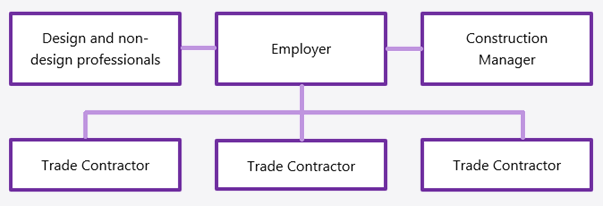In the wake of high-profile main contractor insolvencies like ISG, Buckingham Group, Readie and Henry Construction (to name but a few), there has been a significant emphasis on how employers can effectively terminate contracts in line with insolvency procedures so as to not be exposed to potential claims, and the fallout for sub-contractors and others engaged on projects.
However, that’s only part of the picture. The employer still has to get the project finished to realise its profit; funders require the project to be completed so that its funding can be repaid; and purchasers and tenants all require the project to be finished so they can move in / purchase the project. So while there is rightfully a focus on the immediate effect of main contractor insolvencies, there is still the issue of how an employer gets a half-finished project completed.
Initial Considerations
Before any progress can be made on restarting the works, the employer needs to work with funders, purchasers and tenants so as to comply with any requirements of any third-party agreements entered into.
Then there is where has the project progressed to. If the main contractor’s insolvency has occurred early on, a replacement contractor may well be happy to price for the associated risks of agreeing to enter into a contract on similar terms to that previously agreed (subject to any surveys and a thorough review). This is often the ideal solution for an employer who has spent considerable time getting a base form of contract agreed and approved by all stakeholders.
Where the works on a project have already been significantly progressed – such as where the structural frame and other key risk items have already been completed – any replacement contractor is very unlikely to be willing to assume responsibility for the already completed works or enter into a contract on similar terms to that of the insolvent contractor. Typically, a contractor taking over a project will only agree to manage the completion of the project.
So, what is the procurement solution for a part finished project? Typically, these are not the standard options (i.e. design and build) but rather the more ‘management’ type procurement options. What is key is to get the correct procurement strategy for your project which can help mitigate risks, manage costs, and maintain project timelines with a view to completion. If claims on security – parent company guarantees, bonds etc – may follow from the insolvency, any action taken must also consider how they may be affected to. So an employer in this position must consider the merits and weaknesses of each option carefully.
The Options
On the assumption a typical JCT Design and Build Contract is not going to be an option, the two typical options turned to are: (1) construction management; and (2) management contracting.
Construction Management

As can be seen from the above diagram, the primary difference between construction management and the more typical design and build option is the employer enters into all the contracts with the supply chain (trade contractors) directly. There is a distinct and separate agreement between the employer and a construction manager, as part of which the construction manager agrees to manage the trade contractors.
The liability associated with a construction manager is not the same as a design and build contractor, as they do not take on the risk for design or workmanship directly, but rather only the effective management and completion of the project and seeking to bring the project in on time and within budget. Construction managers are often also main contractors (MACE being a well-known example) but can be professional practices as well.
As well as this different risk profile, as each trade contractor is employed separately, works can commence on certain trades before others are appointed, meaning delays can be minimised.
However, there is a significant increase in client management with this form of procurement. It is seen as complex from a communication and coordination standpoint as there are more parties to liaise with in terms of obtaining key information and documents on the project and vitally getting this coordinated upstream to stakeholders.
Further, there is no single point responsibility that clients and funders prefer. Under a construction management procurement route, accountability can become muddied where there are multiple trade contractors involved and numerous interfaces with disputes over limits of responsibility.
Management Contracting

The other form of ‘management’ procurement is exactly that – management contacting. Management contracting looks very similar to a design and build type procurement method – see the diagram above. However, there are a number of key differences.
While there is a single party engaged by the employer – the management contractor – and all the money flows through them, the liability taken on by the management contractor is akin to that of a construction manager. More ‘senior’ readers may remember the old clause 3.21 of the JCT Standard form of Management Contract 1987 which made clear that the management contractor was not responsible for any breach by a works contractor, so in effect not being responsible for the design carried out by any such works contractors. As with construction management the level of risk taken is far less than a traditional design and build contractor.
The management contractor’s liability extends to it using reasonable skill and care to manage the appointment of works contractors and the build process, and it is responsible for the overall management of the project. It is not responsible for a failure by any particular works contractor (for example with the design). However, the management contractor is not free from any liability, as confirmed by the Court of Appeal in Copthorne Hotel (Newcastle) Ltd v. Arup Associates (No.2) (1997), and it remains liable for its own failure to manage / supervise.
Unlike construction management, the management contracting route has the benefit of a single party being contracted with the employer (so is perhaps more suitable for a client with limited resource / experience in managing numerous trade contractors), but due to the lack of any responsibility for design, the provision of direct agreements between the employer and each works contractor is ever more important – in practice these amount to collateral warranties. Unlike a normal design and build procurement where the main contractor is liable as well as the sub-contractor under management contracting it is just the works contractor, so the provision of such documents is key.
Further issues
Maintaining the supply chain
Whichever option of management type contract may be used, the employer will need to look to maintain the identity of key trades from the original contract to the new form of procurement. Negotiations will need to be had with these key sub-contractors, as generally they will be owed money under the original contract and will want to recover these sums if they are to continue working on the project. Often the employer will have effectively already paid for this work, but the payment will not have made it through to the sub-contractor.
So, a compromise needs to be reached, and often for certain key subbie (for example those carrying out the structural frame, mechanical and electrical works and/or cladding sub-contract packages) it will be important for the employer to maintain the same backbone of contractors so that it has a more complete pack of warranties / guarantees for any funders, purchasers and tenants.
Delays and increased costs
Whichever form of procurement is used the cost of finishing a part-built project is always going to cost more than the original contract sum and there will be inevitable delays. This is where the provision of performance bonds or other forms of security can fill in the gap to cover all or some of the increased cost. Where these are in place, the employer needs to make sure they are not compromising potential claims, and that notification provisions are met.
Summary
Our experience of working for developers after a large contractor insolvency has included each of the management types of procurement, as well reverting to a more typical design and build procurement for jobs not too far progressed. Certainly ‘management’ forms of procurement are becoming more popular given recent main contractor insolvencies and the risks for developers as a result, but there remains a place for other forms of contract.
Whichever form of procurement is used, it is important that employers understand the merits and weaknesses of each type and choose the most appropriate for the particular project. There will be an increased burden of paperwork – this is inevitable – but it is vital that there is proper documentation in place to establish clear duties and responsibilities to protect employers when finishing off a project.







